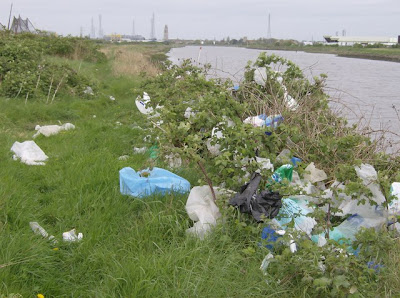RECYCLE OR REUSE: THE DEBATE RAGES ON FOR PLASTIC GROCERY BAGS |
![Creative Commons Licence [Some Rights Reserved]](https://creativecommons.org/images/public/somerights20.gif) © Copyright Graham Horn and licensed © Copyright Graham Horn and licensed for reuse under this Creative Commons Licence. |
While some may revile the ubiquitous plastic grocery bag as the ultimate example of our throw-away society, others argue they aren't that bad if they are recycled. One problem with recycling is that time and energy are expended returning the bags to a store or recycling center.
Altogether, it costs $4,000 to recycle a ton of plastic bags.1 That ton of plastic is then worth $500-$1200 on the open commodities market.2 That’s before it is turned back into plastic bags which only adds to this unequal cost equation. We are only talking about the estimated 5-20% of bags that make it to the recycler. The rest end up as landfill or litter. In the landfill, however, they take up a fraction of the volume paper bags occupy. The litter problem does remain, and it seems governments are unwilling to impose stiffer fines to reduce it.
In another comparison with paper bags, because the plastic bags are light and take up less room, they require only one seventh the number of trucks to transport them to market. This is a great savings in energy spent per bag.3
A reusable canvas bag is an option, but it also comes with disadvantages. The main one is hygiene. Unless you’re buying only canned or boxed foods, you’re going to have to wash it after a few trips. This uses resources and energy. Plus, if you don’t keep them in your car at all times, you’ll find you need to purchase an extra now and then. Hauling them around in your trunk, as little as those several canvas totes weigh, does entail extra fuel costs.
There is one simple solution that hardly anybody talks about. It is to reuse the bags as trash liners in the home instead of recycling them. This short circuits the expensive route from retailer to home to recycler to manufacturer to retailer. This saves the $4,000 per ton expense of recycling. It also saves a household budget the expense of trash can liners, giving consumers an incentive to save every bag and put it to use. And that takes care of the litter problem because it winds up in the landfill where it belongs. There is a common misconception that this adds to the particulate plastic pollution plaguing the oceans, but that is not true. That kind of breakdown, eventually almost to the molecular level, requires sunlight.
One such reuser talks about his experience, “...use wire frames to keep ‘em open and upright, and I put ‘em everywhere I’d use a waste basket or to clean up messes...litter boxes, food trimmings, recycling bins. If you need it to hold liquid just pop open the bag and hold it up to the light. The smallest pinhole shows up.”
|
Image courtesy General Product Development
|
References:
1. Article from the web site reuseit.com - http://bit.ly/LCqUn5
2. Web stie - http://www.theplasticsexchange.com/3. Article from the Aol.news - http://aol.it/MTFigd
Thanks for your time. Comments are welcome.

